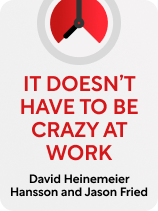

This article is an excerpt from the Shortform book guide to "It Doesn't Have to Be Crazy at Work" by David Heinemeier Hansson and Jason Fried. Shortform has the world's best summaries and analyses of books you should be reading.
Like this article? Sign up for a free trial here.
How can you escape the hustle culture at work? Why shouldn’t you set aggressive goals? How and why should you give your employees private time?
In It Doesn’t Have to Be Crazy at Work, Jason Fried and David Heinemeier Hansson teach you how to build an organization employees would be thrilled to work for. They detail the three qualifications to look for when scouting for any potential hire and why employees need private time to work.
Read below for a brief overview of It Doesn’t Have to Be Crazy at Work.
It Doesn’t Have to Be Crazy at Work Key Points
In today’s “hustle culture,” we imagine the most successful worker as someone who lives at the office, works nights and weekends, and attacks their job with a frantic intensity. In their attempts to embody this ideal, employees, managers, and entrepreneurs end up ruining their lives, trying to get ahead in their careers by sacrificing the time and energy they should be spending on their lives outside of work.
Authors Jason Fried and David Heinemeier Hansson argue that this mindset is not only a recipe for an unsatisfying life, but it’s also ineffective. Most people spending their entire lives in a frenzy at work aren’t getting more work done—they’re burning themselves out with inefficient business practices.
In It Doesn’t Have to Be Crazy at Work, Fried and Hansson contend that companies should establish more reasonable, sustainable goals and business practices that put employees first. In doing so, companies can make their employees’ work lives relaxing and satisfying—while still consistently making money for the business.
According to Fried and Hansson, they know this is possible because they’ve done it themselves. The authors are co-owners of 37signals, the company that created Basecamp—a software tool teams can use at work to organize and complete various projects. They’ve been managing the company together since 2003 and have been publishing books since 2004, sharing management advice they’ve learned through trial and error over the years. Fried and Hansson’s best-selling book is 2010’s Rework, in which they challenge aspects of conventional business wisdom and explore the ways that the internet has revolutionized business practices.
Pursue Stable Success, Not Growth
Fried and Hansson contend that many organizations perpetuate the unhealthy ideals of “hustle culture” through specific management strategies: Namely, they set aggressive quarterly growth targets to push their employees to do their best work. However, such uncompromising, growth-oriented goals needlessly create an unhealthy work environment that degrades employees’ quality of life.
To explain why, we’ll outline some of the downsides of aggressive organizational growth. Then, we’ll cover some of the benefits of the alternative strategy: aiming for stable, consistent success.
Downside #1: Growth Targets Are Demoralizing
First, Fried and Hansson say that growth targets demoralize employees by constantly moving the goalposts of what constitutes well-done work. As soon as the company achieves one arbitrary goal, it starts working toward the next one. This means that no matter how hard they work, employees can never feel relaxed or satisfied because there are always new targets requiring them to do better.
Downside #2: Growth Targets Create Financial Stress
Second, Fried and Hansson assert that aggressive growth targets put the whole company under financial stress, which puts every employee under emotional stress. Many startups spend far more money than they earn on expanding business as quickly as possible—intending to sacrifice short-term profits for long-term revenue growth. However, this strategy pressures the team to execute perfect work; if the company doesn’t hit its growth targets, it goes bankrupt. This pressure will cause your employees to quickly burn out.
Downside #3: Growth Targets Encourage Unethical Behavior
Finally, when companies make it their primary goal to hit growth targets, everyone on the team is more likely to break their promises to the customer and compromise their moral integrity to succeed. For example, in 2016, employees of the bank Wells Fargo who were under pressure to hit certain sales goals opened millions of fraudulent accounts under their customers’ names.
The Alternative: Stable Success
Instead of constantly setting bigger and more ambitious goals for your company, Fried and Hansson recommend defining success for your organization as the ongoing completion of the same stable goals. For instance, you may aim to deliver a product you’re proud of and provide great customer service. Settle into a work routine that makes your team happy and be satisfied with that—as long as the business is profitable, there’s no need to expand it to a scale that’s more stressful to manage. For example, if you run a landscaping business, make it your goal to serve a single city well season after season instead of expanding to manage teams across the country.
This doesn’t mean your organization can’t grow and progress—Fried and Hansson advocate refining and improving your workplace over time. Constantly stay on the lookout for ways to better accomplish your stable goals, as well as ways to make life for you and your employees as enjoyable as possible.
Give Your Employees Private Time
We’ve discussed Fried and Hansson’s belief that companies can create relaxed, healthy work environments by aiming for stable success rather than unlimited growth. However, this doesn’t mean compromising on the quality of their work. A more relaxed workplace can actually be more productive than a frenzied one, as long as you give employees private time to work without being distracted.
The more time someone has to work on a single task without being interrupted, the more they can get done within that time. Even a single brief interruption can fragment someone’s attention and drastically reduce their productivity. For this reason, Fried and Hansson structure their organization to give their employees as much uninterrupted private work time as possible.
To build an organization in which employees have enough private time to get things done, Fried and Hansson offer three tips.
Tip #1: Maintain a Distraction-Free Workspace
Although employees need time by themselves without any distractions to get work done, Fried and Hansson explain that most modern offices give them the opposite: open floor plans in which people take phone calls or make loud conversation where everyone can hear them. Consequently, many employees feel pressured to work during evenings at home, or to come into the office hours early just to have time to get tasks done without distractions. They end up working far more than 40 hours a week and still get less done than they should.
To remedy this, Fried and Hansson recommend running your office like a library—everyone in the public space must be quiet and avoid distracting others. People already know how to behave at the library, so this kind of cultural shift is relatively easy to implement.
Tip #2: Let Workers Keep Their Schedules Private
Fried and Hansson also suggest protecting your team members’ time by allowing them to keep their schedules private. When a worker’s day-to-day schedule is publicly available, it encourages coworkers to claim that person’s time. For instance, if Miranda sees that Amir’s schedule is empty for the next two hours, she might pop into his office to quickly get his opinion on her ideas for improving the company’s training program. This interruption wrecks Amir’s productivity for the whole afternoon, and Miranda’s training program is only slightly improved by his input.
Instead of leaving your employees vulnerable to interruptions whenever they have free time, Fried and Hansson recommend instructing your most knowledgeable employees to host university-style “office hours”: They should schedule a regular time in which coworkers can consult them and save the rest of their time at work solely for themselves. If a coworker needs an expert’s input, they have to wait for their office hours to roll around.
Tip #3: Embrace Asynchronous Communication
According to Fried and Hansson, many organizations hurt their employees’ productivity by creating a culture in which they’re expected to constantly check their messages, stay aware of the discussion going on in real-time chatrooms, and respond as quickly as possible to anyone who mentions them. The threat of missing important information frightens employees into perpetually keeping tabs on all this synchronous communication—at the expense of their personal responsibilities.
To avoid this, the authors recommend relying primarily on asynchronous rather than real-time communication in the workplace. If someone needs to share important information, they shouldn’t just post it in a chatroom and assume that everyone will see it. Instead, they should create a permanent document that relevant team members can consult whenever they want. This way, workers are free to ignore real-time chats and concentrate on their work, trusting that they can seek out necessary information later. That said, if you need to communicate something urgent, real-time chat may be the right tool for the situation.
Another benefit of asynchronous communication is that it facilitates deeper thinking, Fried and Hansson note. When employees share important information and seek collaborative input, they’ll receive more intelligent feedback if other team members have time to think deeply. In contrast, people at most companies present their ideas in real time (for instance, in an in-person meeting) and expect immediate feedback. Consequently, their colleagues’ underdeveloped first impressions compromise their ideas and decisions.
Maintain an Effective Team
We’ll end this guide with a discussion of Fried and Hansson’s perspective that treating your employees as a long-term investment makes your organization a more effective and satisfying place to work. Let’s discuss two of their tips on how to invest in a productive team.
Tip #1: Don’t Hunt for Talented Employees—Create Them
Most companies get skilled employees by identifying the most talented workers in their industry and trying to steal them away from whatever company they’re currently working for. However, transplanting successful employees from other companies can end in disaster if the new recruits struggle to adjust to your organization. Fried and Hansson argue that the more reliable strategy is to hire employees who show promise and help them reach their full potential.
Tip #2: Supply Generous Benefits
Finally, Fried and Hansson recommend supplying your team with enough generous benefits to make them want to stay at your company for the long haul. Retaining your current employees by offering them benefits is more effective than replacing them for a couple of reasons. First, high employee turnover is expensive for your company. Second, every time you hire someone new, your team has to divert time and attention away from serving your customers to conduct interviews and get the new employees up to speed (a long, arduous process).
Many companies entice employees with benefits that seem generous but that incentivize them to spend too much time at work instead of cultivating work-life balance. For example, they deck out the office with ping-pong tables or on-campus workout facilities that are free for employees to use but encourage them to stay at the workplace instead of going home.In contrast, Fried and Hansson recommend offering employees generous benefits that genuinely support employees—especially their lives outside of work. For instance, the authors pay for their employees to take three weeks of vacation every year and even cover the costs of travel and accommodation for their workers.

———End of Preview———
Like what you just read? Read the rest of the world's best book summary and analysis of David Heinemeier Hansson and Jason Fried's "It Doesn't Have to Be Crazy at Work" at Shortform.
Here's what you'll find in our full It Doesn't Have to Be Crazy at Work summary:
- How today's "hustle culture" ruins the lives of many
- How you can establish more reasonable and sustainable goals
- The three qualifications to look for when scouting for any potential hire






